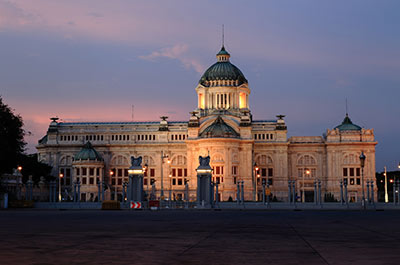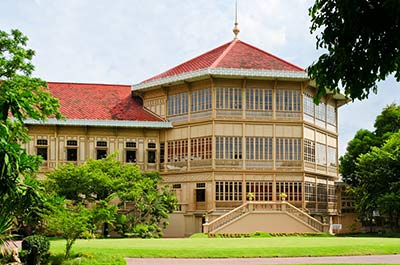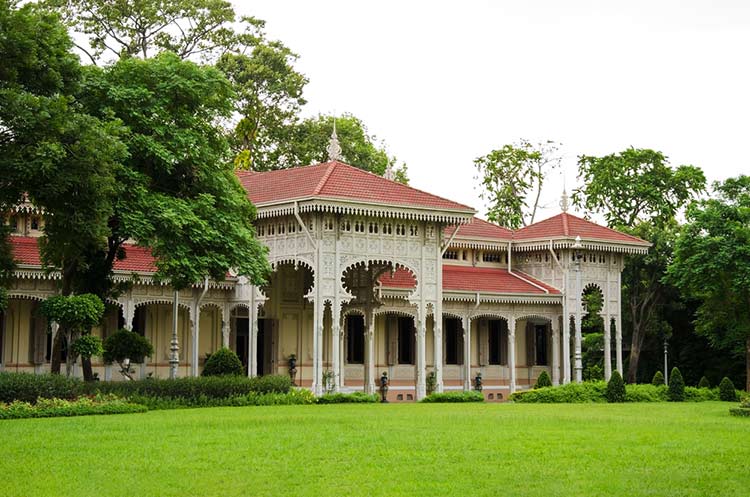
Dusit Palace
Spacious complex of palaces, Royal mansions & throne halls
Dusit Palace is a large, spacious complex of palaces, mansions and throne halls build in Bangkok at the start of the 20th century.
The Grand Palace had been the residence of Thai Kings since the founding of the Rattanakosin Kingdom and its capital Bangkok in 1782. With the number of buildings and residents growing at the Grand Palace, King Chulalongkorn (Rama V) decided to have a new palace build.
Inspired by European palaces
King Chulalongkorn was the first Thai King to visit Europe in 1897. During his travels he became inspired by some of the European palaces he saw with broad boulevards and large, spacious parks.
Towards the end of the 19th century the King acquired farmland in the Dusit area to the North of the old palace. The new Dusit Palace was build on a very large area with more than a dozen palaces, throne halls, Royal mansions and other structures.
The complex was initially named Suan Dusit, which means “heavenly garden” and was later renamed to Dusit Palace.
Thei & European styles
The style of some of the structures show strong European influence, like the Renaissance style Ananta Samakhom Throne Hall, while others are in traditional Thai style.
Today many of the palace buildings have been turned into museums, some of which are open to the public. Currently the Dusit complex is about 16 acres large; the former Royal gardens named Khao Din Wana were turned into the Dusit Zoo in 1938.
Buildings of Dusit Palace
There are over a dozen palaces, throne halls, Royal mansions and other structures at the Dusit Palace complex.
Ananta Samakhom Throne Hall
The impressive and elegant Italian Renaissance style Ananta Samakhom Throne Hall is probably the most eye catching of all structures. Approaching Dusit Palace from Ratchadamnoen Nok road the palace sits at the end of a wide boulevard. A statue of King Chulalongkorn on horseback at the Royal Plaza reminds of the palace builder.
Vimanmek Royal Teak Mansion
The Vimanmek Royal Teak Mansion is an all teak wooden building used by King Rama V as his personal living quarters that has now been turned into a museum. The museum holds a large number of personal items that belonged to King Rama V and it provides an excellent opportunity to see the way the Thai Royals lived at the start of the 20th century.
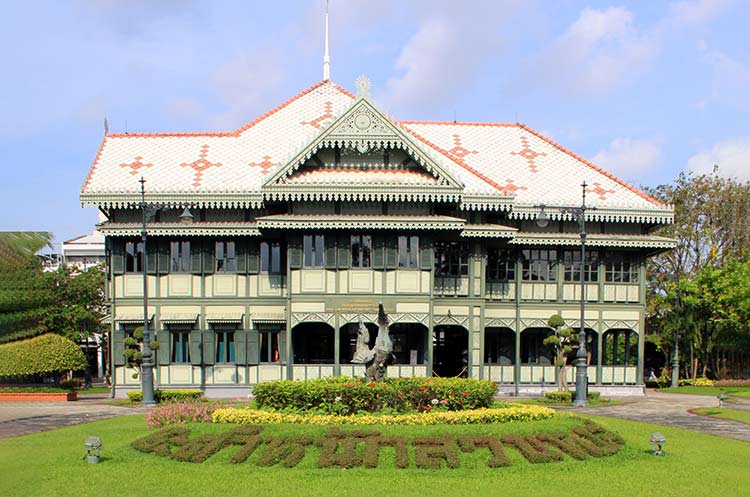
Suan Hong Residential Hall
The Suan Hong Residential Hall was the residence of Queen Savang Vadhana, one of King Chulalongkorn’s consorts. It is also known as “the Swan Garden”, named after the swan that is the mount of Brahma, the Hindu God of creation. The green, two storey building is decorated with intricate wood carvings.
On display are models and photos of the Royal barges and Royal barges procession, photos of the life of HRH Crown Prince Vajiralongkorn, the ordination to monkhood of King Rama IX and the Crown Prince.
Also displayed are photos of important ceremonies in Thailand, such as the annual ploughing ceremony at Sanam Luang to mark the start of the rainy season and rice planting time and other Royal ceremonies like the Royal Swing ceremony, the Royal Investiture and the Royal Tonsure ceremony. Early 2013 the Hall was closed to the public.
Abhisek Dusit Throne Hall
The Abhisek Dusit Throne Hall was build in 1904. It was used to receive important foreign visitors of King Chulalongkorn and as a banquet hall. The single storey, ornate building is decorated with intricate carved flower motifs on its panels and with stained glass windows.
During the early 1990’s the building was renovated and turned into a museum displaying works of traditional Thai art and handicrafts. In 1993 the King and Queen opened the museum sponsored by the SUPPORT foundation. The foundation that was initiated by HM Queen Sirikit aims at preserving traditional Thai handicrafts and the skills to produce them. Among the items on display are niello ware, gold and silver objects sculpted and intricately decorated with various designs, necklaces, brooches, Thai silk items in several designs and colors, wood carvings, soap carvings and silver and gold inlaid items.
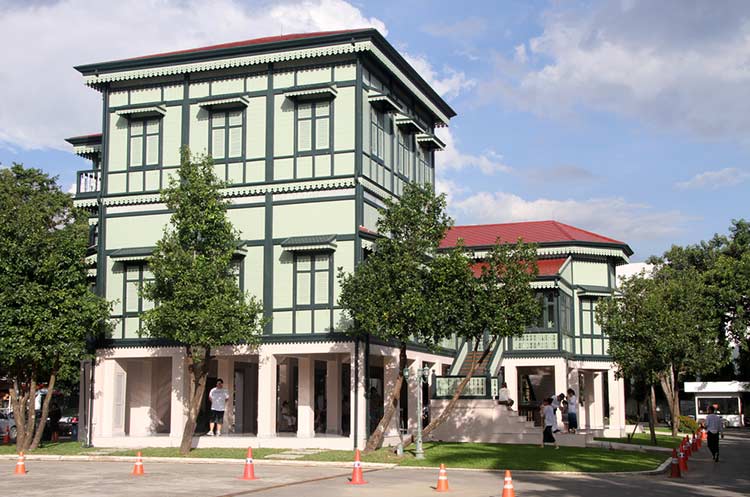
Tamnak Ho Throne Hall
The Tamnak Ho Throne Hall, that is also known the “newlyweds residential hall” was initially part of the Bang Khun Phrom Palace on the banks of the Chao Phraya river. The green, two storey structure was build by King Chulalongkorn for the wedding of his son, HRH Prince Paribatra Sukhumbhand and his wife in 1903.
The building was dismantled and rebuild at its current location in the Dusit Palace complex in 1998. Today the building houses personal items that belonged to Queen Rambhai Barni (the wife of King Rama VII) and pottery from the Sukhothai and Ayutthaya era, that were discovered in shipwrecks found in the Gulf of Thailand. Early 2013 the Hall was closed to the public.
The Royal Carriage Museum
On display are a number of early 20th century carriages used by King Rama V. At the start of the 20th century, Bangkok was known as “the Venice of the East” thanks to its many waterways. King Rama V, inspired by the broad boulevards of European cities decided to fill up canals and convert them into roads to be used by carriages.
The Royal Elephant Museum
The Royal elephant stables turned into a museum displays information about the history and cultural importance of white elephants in Thai history. White elephants are very rare and throughout Thai history have been a symbol of power and wealth for Thai Kings.
Other buildings of Dusit Palace
The Dusit complex further contains the Chitralada Palace, that is used as the primary residence for the Royal Family and therefore not open to the public, as well as several Royal residential halls that were build for King Chulalongkorn’s sisters and other members of the Royal Family.
Two former residential halls, the HRH Princess Bussaban Bua-Phan Residential Hall and the HRH Princess Arun-Wadi Residential Hall are now in use as King Bhumibol Adulyadej’s Royal Photography Museum. Both buildings contain photos taken by HM the King and include photos of the Royal Family, photos taken during the King’s visits to remote areas of the country, nature, landscapes and many more.
Other residential halls that have been turned into museums include the antique clock museum, the cloth and silk museum, and the Ban Chiang Pottery Museum, that displays prehistoric pottery found at the Ban Chiang archaeological site, a village and burial site dating back some 3,500 years and now a UNESCO World Heritage Site.
Location
Dusit Palace is located in the Dusit district, a few kilometers North of the old Rattanakosin area with the Grand Palace.
How to get to Dusit Palace
By far the easiest and most comfortable way to get there is by air conditioned metered taxi.
River boat
The nearest Chao Phraya Express river boat pier is Thewes, from where is a little over one kilometer to the palace complex.
Sky Train and bus
The nearest BTS Sky Train station is Phayathai; from there, follow Si Ayutthaya road to Dusit for about 2½ kilometers. From BTS Skytrain station Victory Monument take bus 515 that stops at Dusit Zoo, next to the palace grounds.
Getting around Bangkok: BTS Sky Train, river boat, MRT Subway, Taxi, Tuk Tuk
Dress code
Please follow the dress code of Royal buildings, meaning long sleeved shirts, long pants or skirts and covered shoulders. In most of the buildings photography is not allowed; please check the signs at each building.
Opening hours
The palace grounds are open daily from 9.30 am until 4 pm.
Entrance fee
Admission charged at the ticket booth is (Thai Baht):
The ticket is valid for all buildings at the Dusit complex that are open to visitors, except for the Ananta Samakhom Throne Hall and the Royal Elephants Museum that require a separate entrance fee of 150 Baht and 50 Baht.
If you have a Grand Palace ticket not older than one week, admission to the Dusit complex is free.
Nearby attractions
- Ananta Samakhom Throne Hall
- Vimanmek Royal Teak Mansion
- Wat Benchamabophit marble temple
- Wat Intharawihan standing Buddha
Palaces in Bangkok
Tours, Trips & Experiences Bangkok
- Bangkok and surroundings
- Private or group
- Full day or half day
